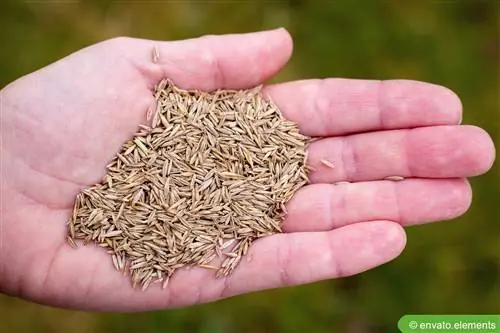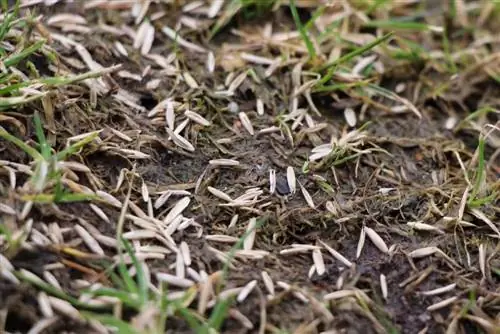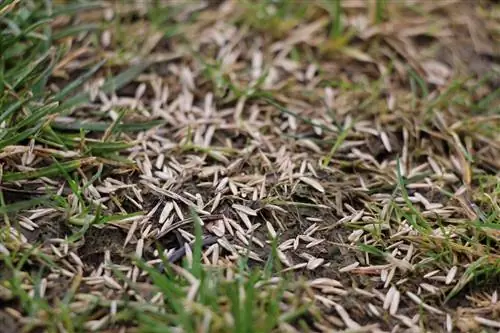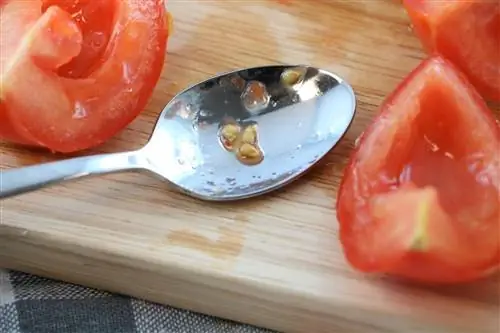- Author admin [email protected].
- Public 2023-12-17 03:39.
- Last modified 2025-06-01 06:48.
At some point, every lawn will have one or two bare spots, which are best repaired with rapid reseeding. Read why simply sprinkling lawn seeds is often not such a good idea.
Just sprinkle lawn seeds?
If it's just a matter of closing smaller gaps in the lawn, simply sprinkling lawn seeds without prior preparation could definitely be successful - at least if the lawn is generally well fertilized and watered. The area should also have been regularly scarified and aerated in advance. However, this approach is not recommended for larger gaps, the removal of unwanted growth, such as wild herbs or moss, or even the creation of a new lawn.

Tip:
Even when closing small gaps, you should loosen the soil a little before sowing. You don't have to dig it up; cultivating it with a cultivator and/or a rake is sufficient in this case.
Risks
Grasses, especially lawn grasses, have high demands on their supply of nutrients and water for he althy growth. If the soil is not prepared appropriately, for example through regular and correct care, both can be missing and thus have a negative impact on the growth of the seedlings. Furthermore, these risks exist if you simply scatter lawn seeds:
- Wind carries seeds away
- Birds eat grass seeds
- Soil possibly solidified/hardened, e.g. B. due to foot traffic or lack of drainage
- Seedlings don't take root properly here
- no vigorous growth possible
- Grasses remain weak and more susceptible to disease and crowding
- previous fertilizing and/or liming may be necessary, e.g. B. due to acidification of the soil
This method is also problematic if the lawn that has already been laid shows symptoms such as moss growth, yellowing or matting. In these cases, simply scattering the seeds is not enough; more care needs to be taken on the entire lawn.
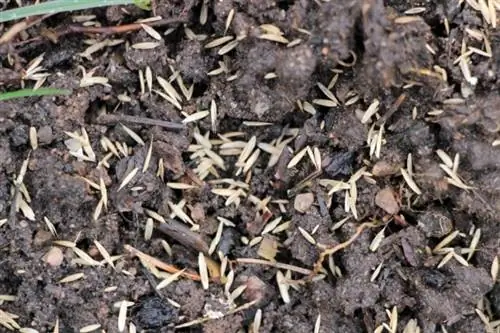
Tip:
After sowing, the sown area must always be kept slightly moist so that the seeds can sprout more easily. The seedlings also need moisture for their growth, but wetness must be avoided.
How to do it right
You should therefore refrain from simply scattering lawn seeds, but instead, if necessary, treat the entire lawn area carefully before sowing the gaps. This also includes areas with little or no vegetation, so don't leave them out! And this is how it works:
- comb out the lawn with a rake
- scarify and aerate (e.g. with special shoes)
- If necessary, fertilize a few days before sowing
- lime if necessary (after pH test)
- Liming should always be carried out approximately four weeks before fertilization and sowing
- loose firm soil with cultivator and rake
- Spread lawn seeds by hand or spreader
- Press seeds lightly with roller
- water thoroughly

Note:
Lawn grasses are light germinators and must therefore under no circumstances be covered with soil. To protect against birds, you can cover the area with a translucent bird protection net. Rolling the surface, however, protects against the seeds being carried away by the wind.
Beware of overdose
Caution is advised when dosing the seeds: Do not simply sprinkle one or more handfuls of seeds onto the tilled or unworked soil, but be sure to follow the manufacturer's recommendation regarding the correct amount. In case of doubt, too much seed can mean that too many seedlings develop and they hinder each other's growth. In this way, thatch quickly develops, which in turn leads to other diseases. However, if you sow too few seeds, a dense lawn will not develop.
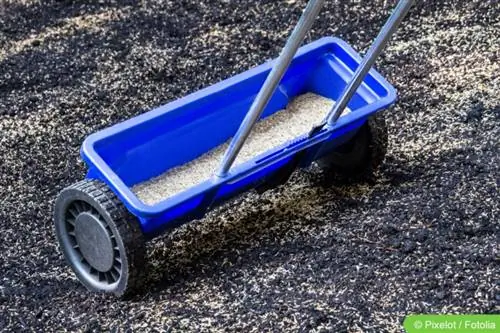
Tip:
Spread the seeds as evenly as possible, which is particularly difficult in larger areas. A spreader that is available with and without electrical support can help here.
Frequently asked questions
How long do lawn seeds take to germinate?
Provided that the growing conditions are optimal and the soil temperature is at least ten degrees Celsius, the first grasses will germinate just eight to ten days after sowing. The fastest way is when the air temperature is between 16 and 23 °C and the sowing area is kept slightly moist. However, the germination speed differs between the different grasses: some grow particularly quickly, others take a little longer. The perennial ryegrass (Lolium perenne) is considered to germinate particularly quickly.
How long do lawn seeds last?
Lawn seeds in the packaging have a shelf life of around three years if stored optimally - dark, dry and cool. Even after this time, you can still plant the seeds, but they lose an average of ten percent of their germination per year. The older the seeds, the worse they germinate. Therefore, if possible, do not use a mixture that is too old, otherwise the desired result may not be achieved.
-

